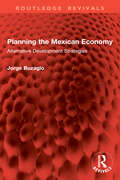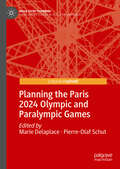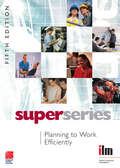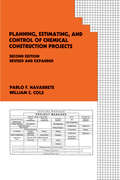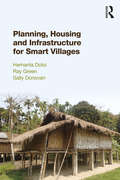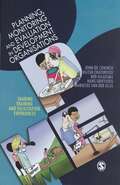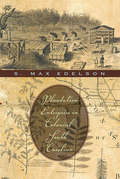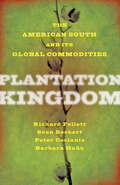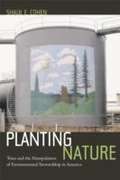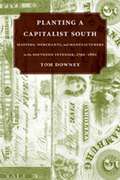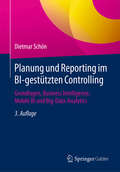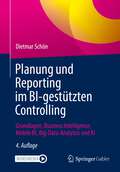- Table View
- List View
Planning in Contemporary Africa: The State, Town Planning and Society in Cameroon (King's SOAS Studies in Development Geography)
by Ambe J. NjohWhy do authorities in post-colonial African states continue to employ European or Western planning models? What are the implications for different societal groups of adopting such models? Several decades following independence, this outstanding volume provides in-depth empirical research to uncover the answers to such questions. The book focuses in particular on Cameroon, the only African country to have been colonized by three different European powers: Germany, Britain and France. It discusses the nature of the state in peripheral capitalist countries and sets current planning and land use policies in their historical, colonial and post-colonial contexts. The author then proceeds to examine key planning issues such as housing, land ownership, sustainable development, environmental and waste management, transportation, infrastructure and gender. In addition to analyzing the impact of colonialism and imperialism on the built environment in Cameroon in particular and sub-Saharan Africa in general, the book also addresses global issues about urbanism and will be particularly relevant to those interested in planning, regional studies and development, and development geography.
Planning of Hybrid Renewable Energy Systems, Electric Vehicles and Microgrid: Modeling, Control and Optimization (Energy Systems in Electrical Engineering)
by Sri Niwas Singh Mohan Lal Kolhe Pradyumn Chaturvedi Aashish Kumar BohreThis book focuses on various challenges, solutions, and emerging technologies in the operation, control, design, optimization, and protection of microgrids in the presence of hybrid renewable energy sources and electric vehicles. This book provides an insight into the potential applications and recent development of different types of renewable energy systems including AC/DC microgrids, RES integration issues with the grid, electric vehicle technology, etc. The book serves as an interdisciplinary platform for the audience working in the focused area to access information related to energy management, modeling, and control. It covers fundamental knowledge, design, mathematical modeling, applications, and practical issues with sufficient design problems and case studies with detailed planning aspects. This book will serve as a guide for researchers, academicians, practicing engineers, professionals, and scientists, as well as for graduate and postgraduate students working in the area of various applications of RES, Electric Vehicles, and AC/DC Microgrid.
Planning the Campaign
by Robert S. Kaplan David P. NortonThe strategy map by itself is simply a static representation of strategy, identifying the outcomes and the drivers of value creation. This chapter describes how adding three ingredients (quantity, defined time line, and select initiatives) transforms the strategy map into a dynamic management tool to guide the selection of strategic initiatives and programs for driving performance breakthroughs.
Planning the Mexican Economy: Alternative Development Strategies (Routledge Revivals)
by Jorge BuzagloThe Mexican economy, like many other economies in the Third World, has grown as the result of a flourishing oil industry. One major problem which faces economic development planners in such economies is how to ensure that development in the oil sector leads on to more general development in the rest of the economy. Often, oil led development may induce agricultural stagnation, increasing food imports, inflation and income concentration.Planning the Mexican Economy (originally published in 1984), based on original research, looks at how this problem has been and might be faced in the Mexican economy. It uses econometric modelling to chart the relationship between different sectors of the economy and to show how change in one factor—such as income redistribution—affects other factors. It puts forward and compares different comprehensive development strategies and makes recommendations about the most effective approaches and policies.
Planning the Paris 2024 Olympic and Paralympic Games (Mega Event Planning)
by Marie Delaplace Pierre-Olaf SchutThis book is the first volume to provide a comprehensive account of mega-event planning for the Paris 2024 Olympic and Paralympic Games. It offers a useful summary of the themes and debates relating to urban planning for the Paris Olympics, based on the results of a research programme (Observatory for Research on Mega-Event) funded by Gustave Eiffel University and Paris Est University and partly carried out with the organisers of the Games and their stakeholders. The authors address all aspects of the bidding process, the organisation of the Games and the construction of the social legacy of the Games.
Planning to Work Efficiently (Institute of Learning & Management Super Series)
by Institute of Leadership & ManagementSuper series are a set of workbooks to accompany the flexible learning programme specifically designed and developed by the Institute of Leadership & Management (ILM) to support their Level 3 Certificate in First Line Management. The learning content is also closely aligned to the Level 3 S/NVQ in Management. The series consists of 35 workbooks. Each book will map on to a course unit (35 books/units).
Planning within Complex Urban Systems
by Shih-Kung LaiImagine living in a city where people could move freely and buildings could be replaced at minimal cost. Reality cannot be further from such. Despite this imperfect world in which we live, urban planning has become integral and critical especially in the face of rapid urbanization in many developing and developed countries. This book introduces the axiomatic/experimental approach to urban planning and addresses the criticism of the lack of a theoretical foundation in urban planning. With the rise of the complexity movement, the book is timely in its depiction of cities as complex systems and explains why planning from within is useful in the face of urban complexity. It also includes policy implications for the Chinese cities in the context of axiomatic/experimental planning theory.
Planning, Estimating, and Control of Chemical Construction Projects (Cost Engineering)
by Pablo F. Navarrete William C. ColeContains added chapters emphasizing the importance of choosing the correct project and defining project goals. Stresses the need for adequate front end loading (FEL) and outlines the responsibility of the venture manager in project selection. Provides updated case studies and examples on technical evaluation criteria, construction progress monitori
Planning, Housing and Infrastructure for Smart Villages
by Sally Donovan Ray Green Hemanta DoloiSome 7.3 billion people currently live on the planet. Of these, 3.4 billion live in rural areas. In just a few regions—Latin America, the Middle East and North Africa—less than 50 per cent of poverty is now located in rural areas. But for the rest of the world's regions between 55 per cent and 80 per cent of the poor continue to live in the countryside. Progress is being made, but much of the knowhow needed is not disseminated outside of a small coterie of professionals who work in the area. With urban development attracting a great deal of attention lately, poorer rural areas deserve the same and new knowledge for empowerment of rural communities is urgently needed. This book provides an overview of current thinking and practices that have emerged over the last thirty years for uplifting rural communities in developing economies. Drawing on a body of knowledge across a spectrum of relevant disciplines, this book provides a range of innovative ideas for rural planning, housing and infrastructure development. Governments in many emerging economies, where rural poverty is often most acute, have attempted to improve livelihoods. Approaches and techniques that have been used for urban development are often not applicable to rural communities. Studies show that money allocated for rural development is often not effectively spent due to distance, lack of infrastructure, lack of education, poverty and other factors. Meanwhile, the gap in development between the city and country continues to grow, sometimes leading to social and political instability, in both developing and developed countries. This book seeks to provide a guidebook for meeting such challenges. Through in-depth enquiry of global practices and thinking about rural development, and selected case studies, the authors argue that careful consideration must be given to incorporating issues of resilience, resourcefulness and the involvement of communities at grassroots levels in realising the transformation of rural settlements into Smart Villages.
Planning, Markets and Rural Housing
by Nick GallentThis book analyses the key forces affecting the affordability of rural homes in Britain and the changing shape of housing markets. It takes as its starting point, demographic trends impacting upon rural communities and upon market dynamics. From this point, it explores consequent patterns of housing affordability, examining changing opportunities in the rental and sale markets, at different spatial scales. The book also focuses on how markets are analysed, and how data are selectively used to demonstrate low levels of affordability, or a lack of need for additional housing in small village locations.Building on the demographic theme, the book considers the housing implications of an aging population, before the focus finally shifts to community initiative in the face of housing undersupply and planning's future role in delivering and procuring a more constant and predictable supply of affordable homes. In a speculative conclusion, the book ends by examining the current political trajectory in England, and the prospects for housing in the countryside in the context of localism and neighbourhood planning at a village level.This book was published as a special issue of Planning Practice and Research.
Planning, Monitoring and Evaluation in Development Organisations: Sharing Training and Facilitation Experiences
by John De Coninck Khilesh Chaturvedi Ben Haagsma Hans Griffioen Mariecke van der GlasPlanning, monitoring and evaluation (PME) remains a challenge for many development organisations, increasingly faced with the rigours of designing and using a well-structured monitoring and evaluation system, and of linking this closely with their planning cycles. Effective PME is, nevertheless, essential for their organisational survival and to enable them to make an effective contribution to sustainable development. This book shares the ′real-life′ experiences of 20 PME trainers and facilitators from Africa, Asia and Europe and offers some suggestions for effective support to PME processes. It focuses on civil society organisations, including NGOs, church-linked development offices, networks, and people′s organisations. A rich selection of examples, success stories, challenges and practical tips are offered. The authors advocate careful and sensitive PME facilitation.
Planning, Politics and City-Making: A Case Study of King's Cross
by Lesley Williams Peter BishopWhilst there is extensive literature analysing the design and function of new buildings and places, the actual process through which development proposals are actually fashioned – through complex negotiation and deal making, involving many different stakeholders with different agendas – is largely undocumented. Conventional planning theory tends to assume a logical, rational and linear decision-making process, which bears little relationship to reality. This book aims to shed some light on that reality. The King’s Cross scheme is one of the largest and most complex developments taking place in Britain today. The planning negotiations, which took six years, were probably some of the most exhaustive debates around a development ever. A report of over 600 pages of technical information was eventually presented to the committee, and after two evenings and ten hours of presentations and debate, the committee approved the scheme by just two votes.
Plano-mestre para Aplicativo Móvel
by Doriane Gaia Mark WestonAprenda a vender Apps para ganhar dinheiro online A revolução do App móvel está aqui, então porque não participar e baixar sua cópia do Plano-mestre para Aplicativo Móvel agora! Já pensou em ganhar dinheiro através da publicação de um App? Sabia que qualquer pessoa pode fazer isso de forma fácil e barata? Desde que o iPhone chegou ao mercado em 2007 os Apps para celulares se tornaram rapidamente a mais nova corrida do ouro no mundo da tecnologia. Com a quantidade de dinheiro gasta em celulares e aplicativos móveis não é surpresa que muitos estão se tornando milionários todos os dias nesta indústria. Não estou dizendo aqui que ao fazer o upload de um App você irá ficar rico da mesma forma, mas vou lhe oferecer uma maneira de construir gradualmente uma fonte de renda passiva. No meu livro, Plano-mestre para Aplicativo Móvel, eu mostrarei o que você precisa fazer para começar a construir um portfólio de Apps para celulares para ganhar uma renda passiva que crescerá dia após dia. Você já ouviu falar de Angry Birds ou Plantas versus Zumbis? Esses são divertidos Apps de games para celulares que se tornaram gigantes. No entanto você não precisa criar um jogo superstar para ganhar dinheiro com Apps. Mesmo os apps mais básicos têm a oportunidade de ganhar dinheiro pelo fato de um grande volume de pessoas, possuir um telefone celular e baixar Apps. Meu livro irá lhe mostrar como você pode começar seu império de App móvel, aproveitando a vantagem que a internet traz para iniciar um negócio, barato e rápido. Você não precisa ter qualquer conhecimento de codificação. Na verdade eu não o aconselho a fazer qualquer tipo de codificação, a menos que você tenha uma ideia fantástica e que seja apaixonado por isso. Se você quer um negócio para ganhar dinheiro, siga o meu conselho, e ele será acrescentado a você muito mais rapidamente. Em poucas palavras,
Plant Closings: International Context and Social Costs
by Robert Perrucci Carolyn C. Perrucci Dena B. Targ Harry R. TargPLANT CLOSED--A sign of the times? These two words have had profound meaning for workers in every factory and office across the country. Millions of workers who have already been displaced by closings have had to pick up the pieces of shattered lives and get on with the business of living. Those who are still working are faced with the insecurity of wondering whether they might find the gates closed some morning when they arrive at work. The number of plant closings and the threat of future closings have raised many questions.What has been happening to the American economy that has resulted in major companies closing their doors? What forces within the international and national political economies are converging to reshape the labor force, eliminating jobs in manufacturing and expanding employment in the lower wage, insecure manufacturing sector? What happens to displaced workers, their families, and the community in which they work?In Plant Closings, the authors examine the reasons plants close and the social, economic, and psychological consequences. A variety of causes are identified including capital flight, decreasing profit rates, and the pursuit of lower labor costs. Through the analysis of a case study the authors examine the changing health patterns, political attitudes, and financial stability of displaced workers. There is also discussion of the impact on the community at large and on the individual institutions within the community. Finally, the authors analyze legislation that addresses the human and social costs of unemployment.Carolyn C. Perrucci is professor of sociology in the Department of Sociology and Anthropology at Purdue University. Robert Perrucci is professor of sociology in the Department of Sociology and Anthropology at Purdue University. Dena B. Targ is professor in the Department of Child Development and Family Studies at Purdue University. Harry R. Targ is professor in the Department of Political Science at Purdue University.
Plant Location Puzzle
by Andrew D. BartmessIn this fictional case study, Ann Reardon, CEO of the Eldora Co. (EDC), has led her organization to become the largest and most profitable bicycle maker in the U.S. market. When her competition was moving its operations overseas because of lower labor costs, she chose to keep EDC's plant on the same campus as corporate headquarters in Boulder, Colorado. She believes that decision has been the primary reason for EDC's success. With the marketing, engineering, and manufacturing staff having easy access to one another, the company has been able to take advantage of the latest technical and stylistic innovations and deliver a more timely product to the retailers. Now, however, the U.S. market is reaching saturation, and the Asian market is nearly doubling annually. EDC's vice president of manufacturing wants Ann to build a new plant in China, but the marketing vice president wants to put a direct sales operation in Asia and outsource production on either a short- or a long-term basis. Manufacturing experts give their views.
Plantation Enterprise in Colonial South Carolina
by S. Max EdelsonThis impressive scholarly debut deftly reinterprets one of America's oldest symbols--the southern slave plantation. S. Max Edelson examines the relationships between planters, slaves, and the natural world they colonized to create the Carolina Lowcountry. European settlers came to South Carolina in 1670 determined to possess an abundant wilderness. Over the course of a century, they settled highly adaptive rice and indigo plantations across a vast coastal plain. Forcing slaves to turn swampy wastelands into productive fields and to channel surging waters into elaborate irrigation systems, planters initiated a stunning economic transformation. The result, Edelson reveals, was two interdependent plantation worlds. A rough rice frontier became a place of unremitting field labor. With the profits, planters made Charleston and its hinterland into a refined, diversified place to live. From urban townhouses and rural retreats, they ran multiple-plantation enterprises, looking to England for affirmation as agriculturists, gentlemen, and stakeholders in Britain's American empire. Offering a new vision of the Old South that was far from static, Edelson reveals the plantations of early South Carolina to have been dynamic instruments behind an expansive process of colonization. With a bold interdisciplinary approach, Plantation Enterprise reconstructs the environmental, economic, and cultural changes that made the Carolina Lowcountry one of the most prosperous and repressive regions in the Atlantic world.
Plantation Goods: A Material History of American Slavery
by Seth RockmanAn eye-opening rethinking of nineteenth-century American history that reveals the interdependence of the Northern industrial economy and Southern slave labor. The industrializing North and the agricultural South—that’s how we have been taught to think about the United States in the early nineteenth century. But in doing so, we overlook the economic ties that held the nation together before the Civil War. We miss slavery’s long reach into small New England communities, just as we fail to see the role of Northern manufacturing in shaping the terrain of human bondage in the South. Using plantation goods—the shirts, hats, hoes, shovels, shoes, axes, and whips made in the North for use in the South—historian Seth Rockman locates the biggest stories in American history in the everyday objects that stitched together the lives and livelihoods of Americans—white and Black, male and female, enslaved and free—across an expanding nation. By following the stories of material objects, such as shoes made by Massachusetts farm women that found their way to the feet of a Mississippi slave, Rockman reveals a national economy organized by slavery—a slavery that outsourced the production of its supplies to the North, and a North that outsourced its slavery to the South. Melding business and labor history through powerful storytelling, Plantation Goods brings northern industrialists, southern slaveholders, enslaved field hands, and paid factory laborers into the same picture. In one part of the country, entrepreneurs envisioned fortunes to be made from “planter’s hoes” and rural women spent their days weaving “negro cloth” and assembling “slave brogans.” In another, enslaved people actively consumed textiles and tools imported from the North to contest their bondage. In between, merchants, marketers, storekeepers, and debt collectors laid claim to the profits of a thriving interregional trade. Examining producers and consumers linked in economic and moral relationships across great geographic and political distances, Plantation Goods explores how people in the nineteenth century thought about complicity with slavery while showing how slavery structured life nationwide and established a modern world of entrepreneurship and exploitation. Rockman brings together lines of American history that have for too long been told separately, as slavery and capitalism converge in something as deceptively ordinary as a humble pair of shoes.
Plantation Kingdom: The American South and Its Global Commodities (The Marcus Cunliffe Lecture Series)
by Sven Beckert Richard Follett Barbara M. Hahn Peter CoclanisHow global competition brought the plantation kingdom to its knees.In 1850, America’s plantation economy reigned supreme. U.S. cotton dominated world markets, and American rice, sugarcane, and tobacco grew throughout a vast farming empire that stretched from Maryland to Texas. Four million enslaved African Americans toiled the fields, producing global commodities that enriched the most powerful class of slaveholders the world had ever known. But fifty years later—after emancipation demolished the plantation-labor system, Asian competition flooded world markets with cheap raw materials, and free trade eliminated protected markets—America’s plantations lay in ruins.Plantation Kingdom traces the rise and fall of America’s plantation economy. Written by four renowned historians, the book demonstrates how an international capitalist system rose out of slave labor, indentured servitude, and the mass production of agricultural commodities for world markets. Vast estates continued to exist after emancipation, but tenancy and sharecropping replaced slavery’s work gangs across most of the plantation world. Poverty and forced labor haunted the region well into the twentieth century.The book explores the importance of slavery to the Old South, the astounding profitability of plantation agriculture, and the legacy of emancipation. It also examines the place of American producers in world markets and considers the impact of globalization and international competition 150 years ago. Written for scholars and students alike, Plantation Kingdom is an accessible and fascinating study.
Planters Nuts
by Robert J. Dolan Donald NgweIn 2012 Planters had about $1 billion in U.S. annual revenues, but had experienced declining unit sales and household penetration over the past six years. The snack nuts category was growing overall, but household spending was shifting away from peanuts, cashews, and mixed nuts-Planters' core business-to almonds and pistachios. A new brand management team for Planters had to develop a plan to reinvigorate the still largest brand in the category, and specifically to decide whether to focus on rebuilding its traditional product categories or on attempting to capitalize on the newer nut categories. Central to this process were questions of segmentation, targeting, and positioning.
Planters Nuts (B): The Power of the Peanut
by Robert J. Dolan Donald NgweThis case picks up from the events in Planters Nuts and describes how the new management team for Planters turned the brand around in 2013 by implementing a new brand positioning accompanied by a multimillion dollar marketing campaign.
Planting Nature: Trees and the Manipulation of Environmental Stewardship in America
by Shaul Ephraim CohenShaul E. Cohen exposes how big business, the government, and tree planting groups often work together to manipulate trees - and the people who plant them. He reveals how positive associations and symbols invested in trees are exploited by an interlocking network of government agencies, private timber companies, and nongovernmental organizations to subvert the power of people who think that they are building a better world. Cohen traces the roots of the story in the history of tree planting in the United States, the rise of popular sentiment around trees, the development of the Arbor Day holiday, and the growth of tree-planting groups such as the National Arbor Day Foundation and American Forests. Drawing from internal papers, government publications, advertisements, and archival documents, Cohen illustrates how organizations promote tree planting to deflect attention from the causes of environmental problems, masking business-as-usual agendas. Ultimately, Planting Nature challenges the relationships between a "green" public, the organizations that champion environmental causes, and the powers that be, providing a cautionary tale of cooperation and deception that cuts across the political spectrum.
Planting a Capitalist South: Masters, Merchants, and Manufacturers in the Southern Interior, 1790--1860
by Tom Downey"This is a pathbreaking book, well grounded in the appropriate documentary record. Downey makes especially good use of the reports of the South Carolina Canal and Rail Road Company and of other corporations, which are so tedious to read, to offer an exciting and fresh perspective on an old problem of vital importance, the relationship between businessmen and planters in the Old South" -- American Historical Review"Downey's book has many merits. First of all, it successfully presents a comprehensive and harmonious picture of the development of the region. Second, it helps to better define the contours of the long misunderstood southern political economy and its transformations during the latter part of the antebellum era. It is indeed a well-written and well-thought piece of historiography showing in microcosm how a new synthesis of antebellum southern history should be conceived." -- Enterprise and SocietyIn Planting a Capitalist South, Tom Downey effectively challenges the idea that commercial and industrial interests did little to alter the planter-dominated political economy of the Old South. By analyzing the interplay of planters, merchants, and manufacturers, Downey characterizes the South as a sphere of contending types of capitalists: agrarians with land and slaves versus commercial and industrial owners of banks, railroads, stores, and factories. His book focuses on the central Savannah River Valley of western South Carolina, an influential political and economic region and the home of some of the South's leading states' rights and proslavery ideologues; which also spawned a number of inland commercial towns, one of the nation's first railroads, and a robust wage-labor community. As such, western South Carolina provides a unique opportunity for looking at contrasting economic forces but solely within the boundaries of the South -- slavery vs. free labor, industrial vs. agricultural, urban vs. rural. A revisionary study, Planting a Capitalist South offers clear evidence of a burgeoning transition to capitalist society in the Old South. "Downey's book is a welcome new addition to the growing corpus of studies seeking to understand the lives of white merchants and manufacturers. Well written and researched, Downey's excellent work will add greater nuance to our picture of the social and economic life of the Old South, particularly our picture of the emerging southern middle class." -- Georgia Historical Quarterly"Planting a Capitalist South makes several important contributions. The idea that commerce and industry challenged tenets of republican ideology may be a familiar one, but Downey pursues it in directions seldom explored by previous historians of the Old South, examining conflicts over issue like railroad routes, water rights, and the power of town governments. Moreover, he links those subjects to historians' debates about the capitalist character of the region, and he stakes out an innovative position with his argument that the late antebellum South was in the midst of a transition to capitalism." -- Business History Review
Planting for a Global Harvest
by Kenichi OhmaeGrowing a global organization is like growing a garden: there must be a proper fit between organization and environment. Achieving that fit means starting by decomposing the corporate center. Global companies need several regional headquarters. They must also make sure their far-flung managers have a shared identity, which comes from instilling a shared set of values. Global competitors invest in markets for the long haul. The shortsightedness of governments or the short-term setbacks of a downturn shouldn't prevent a company from considering the whole world a garden, ready for cultivation.
Planung und Reporting im BI-gestützten Controlling: Grundlagen, Business Intelligence, Mobile BI und Big-Data-Analytics
by Dietmar SchönPlanungs- und Reportinglösungen leiden in vielen Unternehmen immer noch unter mangelnder Datenqualität, sind unzureichend integriert und häufig zeit- und kostenintensiv.Dieses praxisorientierte Buch zeigt Schritt für Schritt, wie es anders geht. Es wird systematisch gezeigt, wie moderne Planungs- und Reportingsysteme im BI-gestützten Controlling mit dem Einsatz von Data-Warehouse- und Big-Data-Technologie aufgebaut werden.Für die 3. Auflage wurde das Buch umfassend aktualisiert. Hierbei wurde ein umfangreiches Beispiel mit Cockpitvorschlägen für die Bereiche Unternehmensleitung, Vertrieb, Einkauf und Projektsteuerung ergänzt. Zudem werden die neusten Entwicklungen im BI-gestützten Controlling mit Unterstützung der traditionellen und explorativen BI aufgezeigt, u. a. Data Mining, Predictive Analytics, Data Discovery, Data Visualization, App-Technologie, Self Service BI sowie Cloud Computing. Weitere Neuerungen betreffen die Themen Datenqualität und Datenmodellierung. Den Abschluss bildet weiterhin das wichtige Kapitel „Mobile BI“, bei dem es um den Ausbau von leistungsfähigen mobilen Analyse- und Planungslösungen mithilfe von Tablets, Handys und anderen mobilen Endgeräten geht.
Planung und Reporting im BI-gestützten Controlling: Grundlagen, Business Intelligence, Mobile BI, Big-Data-Analytics und KI
by Dietmar SchönPlanungs- und Reportinglösungen leiden in vielen Unternehmen immer noch unter mangelnder Datenqualität, sind unzureichend integriert und häufig zeit- und kostenintensiv. Dieses praxisorientierte Buch zeigt Schritt für Schritt, wie es anders geht. Es wird systematisch gezeigt, wie moderne Planungs- und Reportingsysteme im BI-gestützten Controlling mit dem Einsatz von Data-Warehouse- und Big-Data-Technologie aufgebaut und sinnvoll um KI-gestützte Features ergänzt werden können. Für die 4. Auflage wurde das Buch umfassend aktualisiert. Hierbei wurde das umfangreiche Controlling-Cockpit-Beispiel erweitert. Es enthält nun Vorschläge für die Bereiche Unternehmensleitung (operatives und strategisches Controlling), Vertrieb, Produktion, Einkauf und Projektsteuerung. Zudem werden die neusten Entwicklungen im BI-gestützten Controlling mit Unterstützung der traditionellen und explorativen BI aufgezeigt, u.a. Data Mining, Predictive Analytics, Künstliche Intelligenz, RPA, Chatbots, Data Discovery, Data Visualization, App-Technologie, Self Service BI sowie Cloud Computing. Weitere Neuerungen betreffen die Themen Datenqualität und Datenmodellierung. Den Abschluss bildet weiterhin das Kapitel „Mobile BI“, bei dem es um den Ausbau von leistungsfähigen mobilen Analyse- und Planungslösungen mit Hilfe von Tablets, Handys und anderen mobilen Endgeräten geht.



